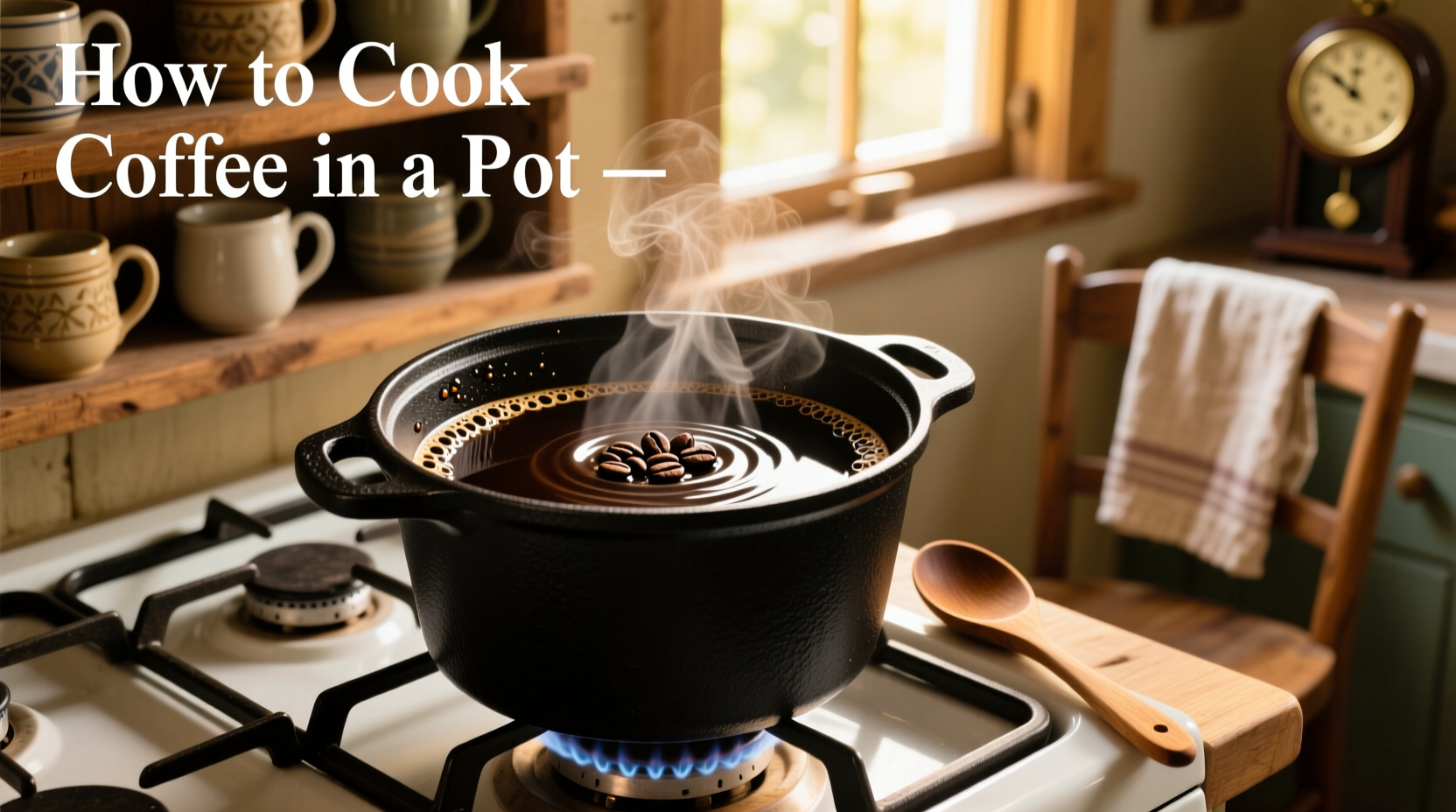Bring 4 cups of water to 195-205°F (90-96°C), add 3 tablespoons of coarsely ground coffee per cup, simmer for 4-5 minutes without boiling, then remove from heat and let settle for 1 minute before carefully pouring. This traditional stovetop method creates rich, full-bodied coffee without special equipment.
Master the Art of Simple Pot-Brewed Coffee
Discover how to make exceptional coffee using just a regular pot and stove—no expensive machines required. This time-tested method delivers a rich, aromatic cup that surpasses many automated brewers when executed properly. In just 7 minutes with basic equipment, you'll create coffee with balanced flavor and body that showcases your beans' true character.
Your Essential Brewing Toolkit
Before starting, gather these simple items:
- Medium-sized stainless steel or enameled pot with lid
- Fine-mesh sieve or cheesecloth
- Medium-coarse ground coffee (burr grinder setting #7)
- Kitchen thermometer (optional but recommended)
- Wooden spoon
| Brewing Method | Coffee:Water Ratio | Optimal Temp | Brew Time |
|---|---|---|---|
| Stovetop Pot | 1:16 | 195-205°F | 4-5 min |
| Pour Over | 1:17 | 200°F | 2:30-3:30 |
| French Press | 1:15 | 200°F | 4 min |
This comparison from the Specialty Coffee Association's brewing standards shows why the pot method creates a uniquely balanced extraction when properly executed. Unlike automated methods, you control every variable for customized results.
The Perfect Pot-Brewed Coffee: Step-by-Step
Phase 1: Water Preparation (Critical First Step)
Measure 4 cups (32 oz) of fresh, filtered water into your pot. Heat over medium flame until thermometer reads 195-205°F (90-96°C). Never boil the water—excessive heat scalds coffee, creating bitterness. Watch for the first wisps of steam and tiny bubbles forming at the pot's edges, indicating proper temperature.
Phase 2: Coffee Addition & Initial Stir
Remove pot from heat and add 12 tablespoons (¾ cup) of coarsely ground coffee. Gently stir with wooden spoon for 10 seconds to ensure all grounds are saturated. Return to lowest possible heat setting—your goal is to maintain temperature without boiling.
Phase 3: Controlled Simmering Process
Maintain gentle heat for exactly 4 minutes. You should see small bubbles occasionally breaking the surface, but no rolling boil. This precise timing follows research from National Coffee Association guidelines showing optimal extraction occurs between 4-5 minutes for immersion methods.
Phase 4: Settling & Serving
After 4 minutes, remove from heat and let stand covered for 60 seconds. This allows grounds to settle. Carefully pour through a fine-mesh sieve into your cup, stopping before disturbing the sediment layer. For cleaner results, line the sieve with cheesecloth.

Why This Method Creates Superior Flavor
The pot method's magic lies in controlled temperature immersion. Unlike drip methods that use single water passes, full immersion extracts balanced flavors from all coffee particles. Food scientists at UC Davis have documented how this technique preserves delicate aromatic compounds that automated brewers often miss.
Troubleshooting Common Issues
Bitter Coffee Fix
If your coffee tastes bitter, you've likely exceeded 205°F or brewed too long. Next time: reduce heat slightly and shorten brewing time by 30 seconds. Always remove from heat immediately after the 4-minute mark.
Weak Coffee Solution
For stronger coffee without bitterness, increase coffee ratio to 1:14 instead of boiling longer. Add an extra tablespoon of coffee per cup rather than extending brew time.
Sediment Management
For cleaner coffee: use coarser grind, pour more slowly, and stop pouring when you see sediment beginning to flow. A double layer of cheesecloth in your sieve captures nearly all particles.
Customization Options for Personal Taste
Strength adjustment: Modify the coffee-to-water ratio between 1:14 (strong) and 1:18 (mild) based on preference.
Flavor enhancement: Add a pinch of salt before brewing to reduce bitterness, or a cinnamon stick during simmering for subtle spice notes.
Water quality matters: Hard water can mute flavors—use filtered water if your tap is high in minerals.
When This Method Works Best (Context Boundaries)
This technique shines when:
- You need multiple cups quickly
- Power is unavailable (camping, emergencies)
- Using high-quality single-origin beans
- Seeking full-bodied, traditional coffee experience
Avoid this method when:
- Need single-serve precision
- Using very light roast delicate beans
- Want completely sediment-free coffee
- Don't have temperature monitoring capability
Advanced Tips from Professional Kitchens
Temperature precision: Keep a dedicated thermometer in your coffee station—water just below boiling (195-205°F) extracts optimal flavor without bitterness.
Bean selection: Medium roasts work best for this method. Dark roasts can become overly bitter, while light roasts may taste under-extracted.
Cleaning tip: After brewing, rinse pot immediately with cold water before grounds set. For stubborn residue, simmer equal parts water and white vinegar, then rinse thoroughly.











 浙公网安备
33010002000092号
浙公网安备
33010002000092号 浙B2-20120091-4
浙B2-20120091-4